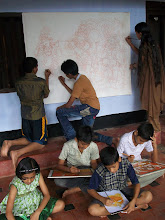Vjanjana : the peculiar potency of language which triggers the Dhvani experience literally means “revelation” as against mere suggestion.
the power of the unstated inner meaning:
the Rg Veda (X.71.4) it is stated that:
Many who see do not see language. Many who hear do not listen to it. It (language) reveals itself like a loving and well-adorned wife to her husband (to those who understands the true nuances of language).
Another important passage from Rg Veda (I.164.45):
Four are the definite grades of speech.The learned and wise know them.Three of them are deposited in secret.They indicate no meaning to common man.Men speak the fourth grade of speech Which is phonetically expressed.
Alamkâra Theory :poetic embellishments :
figures of speech (sabdalamkâra) and figures of sense (arthalamkâra)
In fine arts (chitrakalâ), sculpture (silpa) and architecture (vâstu), the form needs adornment. Thus, the essence of alamkâra can be said to pervade most art forms. In a still wider sense a building is adorned by painting and sculpture
Doshas and Gunas :A work of art, in order to be successful must avoid certain defects and display certain positive qualities. This applies to fine arts as well as to the other art forms
Riti or style :. Appropriateness of style to theme is its essential point, (its relative nature recognized by Dândin), and thus it pervades all art forms, consciously or unconsciously.
Style and Signature
If a painter signs his paintings, won’t he be unjustly taking credit for the techniques and styles of the old masters, which he has imitated? Moreover, if he signs his works, won’t he be saying,: ’ my paintings bear my imperfections’.
'Imperfection is the mother of style':
“He taught me how the hidden fault of ‘style’ isn’t something the artist selects of his own volition, but is determined by the artist’s past and his forgotten memories. He also showed me how these secret faults, weaknesses and defects, at one time such a source of shame they were concealed so we wouldn’t be estranged from the old masters, will henceforth emerge to be praised as ‘personal characteristics’ or ‘style’ because the European masters have spread them over the world.
Henceforth, thanks to fools who take pride in their own shortcomings, the world will be more colourful and more stupid and of course, a much more imperfect place.”
from Orhan Pamuk’s ‘My Name is Red ‘
Vakrokti the problem of differentiating poetic language from ordinary language.
Aucitya or appropriateness : In simple words, there must be a fit between theme and form and this is so in all aesthetic fields.
